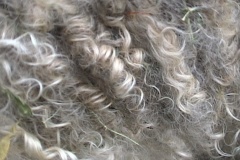Mohair
| Infobox on Mohair | |
|---|---|
| Example of Mohair |  |
| Facts | |
| Origin | - |
| Stowage factor (in m3/t) | 7,36 m3/t (bags, not pressed), 2,97/4,25 m3/t (packing) |
| Humidity / moisture | - |
| Ventilation | - |
| Risk factors | See text |
Mohair
Description
Mohair usually refers to a silk-like fabric or yarn made from the hair of the Angora goat. Mohair fiber is approximately 25–45 microns in diameter. It is one of the oldest textile fibers in use. It is both durable and resilient. It is notable for its high luster and sheen, which has helped give it the nickname the "Diamond Fiber", and is often used in fiber blends to add these qualities to a textile. Mohair takes dye exceptionally well. Mohair is warm in winter as it has great insulating properties, while remaining cool in summer due to its moisture wicking properties. It is durable, naturally elastic, flame resistant, crease resistant, and does not felt. It is considered to be a luxury fiber, like cashmere, angora and silk, and is usually more expensive than most wool that comes from sheep.
Mohair is composed mostly of keratin, a protein found in the hair, wool, horns and skin of all mammals. While it has scales like wool, the scales are not fully developed, merely indicated. Thus, mohair does not felt as wool does.
Mohair increases its diameter with the age of the goat, growing along with the animal. Fine hair from younger animals is used for finer applications such as clothing, and the thicker hair from older animals is more often used for carpets and heavy fabrics intended for outerwear.
The term mohair is sometimes used to describe a type of material used for the folding roof on convertible cars. In this instance, mohair refers to a form of denim-like canvas. Mohair should not be confused with the fur from the angora rabbit, which is called angora wool.
Mohair is shorn from the goat without harming the animal. Shearing is done twice a year, in the spring and in the fall. One goat will produce 5–8 kg of mohair a year. Shearing is done on a clean swept floor with extra care taken to keep the hair clean and free of debris. The hair is then processed to remove natural grease, dirt and vegetable matter. Mohair grows in uniform locks. Angora is a single-coat breed, and unlike pygora or cashmere, there is no need to dehair a mohair fleece to separate the coarse hair from the down hair.
South Africa is the world's largest mohair producer, producing around 50% of the total world production.
Application
Mohair is used in scarves, winter hats, suits, sweaters, coats, socks and home furnishing. Mohair fiber is also found in carpets, wall fabrics, craft yarns, and many other fabrics, and may be used as a substitute for fur. Because its texture resembles fine human hair, mohair is often used in making high grade doll wigs or in rooting customized dolls.
Mohair is not a soft yarn, when compared with alpaca or cashmere, or synthetic fibers or wools that have been treated and blended with other fibers to enhance softness. On the other hand, mohair is valued for certain unique characteristics: it is warmer than other fibers, even when used to make a light-weight garment, and is often blended with wool for this reason; and mohair fibers have a distinctive luster created by the way they reflect light. Combined with mohair's ability to absorb dyes exceptionally well, pure mohair yarns are usually recognizable for their vivid saturated colours.
Fibers from young goats are softest and are used to manufacture yarn for clothing. Fibers from mature goats are used to produce such things as rugs and carpets. Mohair is also used in 'climbing skins' for randonnee skiing. The mohair is used in a carpet allowing the skier an appropriate ascension method without sliding downhill.
Shipment / Storage / Risk factors
The hair of the Angora goat is used for weaving cloth. Shipped in bags or bales. Subject to loss in weight due to drying. Liable to heat.











